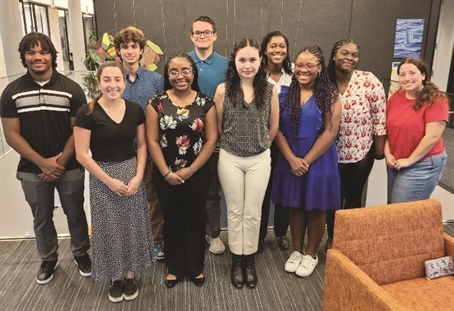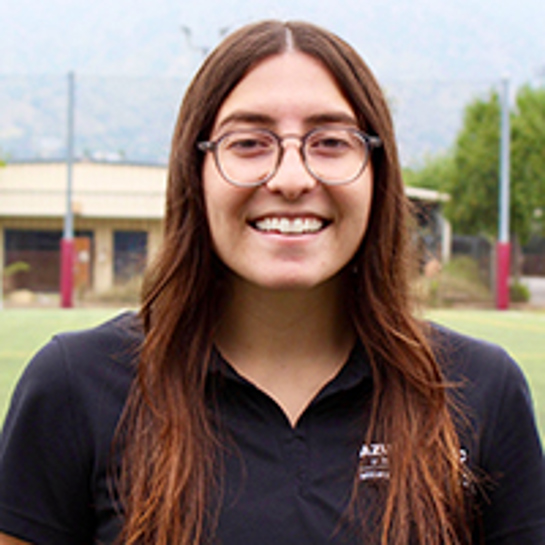Reflections From a Student in the SIAM-Simons Undergraduate Summer Research Program
2023 introduced the SIAM community to the newly established SIAM-Simons Undergraduate Summer Research Program, and I was privileged to participate in the first cohort last summer. The program provides monetary support for 10 undergraduate students to work with faculty mentors, conduct and communicate scientific research, and learn about careers in applied mathematics and computational science. Here, I wish to introduce this opportunity to the broader SIAM community and extoll its benefits to students from underrepresented groups, such as people of color like myself.
Before participants begin their research, they are assigned to one of five sites across the U.S. and paired with another undergraduate student who has similar interests. Then, both students are matched with a mentor who offers suggestions for prospective research topics. For example, Drake Lewis of Kenyon College and I studied simultaneous localization and mapping (SLAM) at Rice University in Houston, Texas, under the direction of Dr. Illya Hicks, the Department Chair of Computational Applied Mathematics and Operations Research.
Throughout the program—which lasts for a total of either six or eight weeks, depending on site assignment—all students take part in weekly Zoom meetings with each other. The entire cohort also visits the Simons Foundation’s Flatiron Institute in New York City. During our in-person visit, we presented our work, engaged in a question-and-answer session with a panel of researchers, and toured the Institute — all of which inspired gratitude for the generosity of the Simons Foundation. Spending time with the other students also fostered a sense of connection between us. Ultimately, we concluded our summer placements by writing research papers and preparing presentations for upcoming conferences. This remarkable academic opportunity was meticulously orchestrated, with each component contributing uniquely to the experience as a whole.
As I mentioned, my research project focused on SLAM: a technique that autonomous devices—such as rovers and self-driving cars—employ to map their surroundings and pinpoint their location within an environment. Drake and I delved into a variety of graph theory problems in order to better understand SLAM, with specific emphasis on a method called pose graph optimization (PGO) that involves a minimum cycle basis (MCB) computation. Similar to a basis of a vector space, a cycle basis of a graph is a maximal linearly independent set of cycles that can generate all other cycles in the graph. Suppose that a graph’s edges have nonnegative weights; the weight of a cycle basis is then the sum of the weights of the basis elements.
PGO uses diverse robotics features to minimize the accuracy gap between a robot’s estimated and actual positions—which enhances SLAM’s effectiveness—while MCB forms the graph’s bases with minimum weight in the calculation. Furthermore, the all-pairs shortest path (APSP) represents the shortest path from a root to all nodes in a graph and is vital in the search for the MCB. In brief, we rely on APSP to find the MCB, which is essential for PGO, which optimizes SLAM. Even though we did not have enough time for a full robotics implementation, we successfully computed all other necessary components of the problem.
Throughout my eight weeks with the SIAM-Simons program, Dr. Hicks imparted valuable strategies that significantly heightened my learning experience. He emphasized the importance of seeking guidance, encouraged us to ask questions, and reassured us that it’s okay to not immediately comprehend new material and concepts. Many participants were conducting research for the first time, and it is important to recognize that perfection is not the expectation; in fact, refraining from asking questions due to potential embarrassment can be far more detrimental. Because I knew nothing about SLAM before arriving at Rice, Dr. Hicks helped me select appropriate reading materials. He advised me to assess a book’s first chapter and switch to a more comprehensible text if necessary, which enhanced my understanding of research techniques and proved especially beneficial as I navigated the complexities of graph theory.
The research process reflects the distinctive approaches and challenges of each problem and is therefore unique for everyone. Drake and I committed 35-40 hours to our research project each week and established a routine of meeting twice a week with our mentor; these gatherings served as concrete opportunities to share progress, ask for guidance, and receive literature recommendations. As part of our research process, we created a collaborative project outline with Dr. Hicks that provided us with checkpoints to improve time management. Every week, we read and annotated relevant articles before transitioning to the coding task at hand. Yet despite these distinct steps, the process was far from linear. For example, sometimes Drake and I had to explore additional articles or books from the library because our initial resources were insufficient. Some days were marked by programming challenges with limited progress, while others brought significant strides that allowed us to complete our weekly tasks ahead of schedule. I learned that these ebbs and flows are a normal part of the research process. Thankfully, SIAM-Simons participants can brave the highs and lows with their partners and collaborate to solve unexpected problems, which makes the entire process less daunting.

I’d like to particularly highlight the importance of sustained communication, as insights from weekly Zoom meetings with the other eight SIAM-Simons students and their mentors—as well as Dr. Karen Bliss (Senior Manager of Education and Outreach at SIAM) and occasional guests—certainly contributed to my overall academic growth. Each meeting offered a unique element of value. For example, the first get-together covered important reminders, discussed SIAM membership and other relevant information, and prepared us for our visit to the Flatiron Institute. During the following week’s check-in, a panel of applied mathematicians of color shared insightful experiences, encouragement, and advice that resonated with my own journey. The third week acquainted us with graduate students who spoke about funding strategies and introduced a wealth of resources for fellowships and paid internships. And during the last meeting, we presented our research and practiced effective communication techniques.
My participation in the SIAM-Simons Undergraduate Summer Research Program provided firsthand insight into the research process, played a pivotal role in my professional development, and cemented my sense of community within the field of applied mathematics. The program offered me a unique opportunity to collaborate with a diverse group of students, which yielded new insights and expanded my perspective. I learned so much from Drake and had a lot of fun working with him; some of my fondest memories from this experience are our conversations during breaks from reading and coding. The SIAM-Simons program also sets participants apart academically, and engaging in undergraduate research helps students stand out when applying for internships, graduate school, and jobs.
I would encourage future participants to embrace any initial discomfort or uncertainties because these feelings signal personal growth. Learning occurs when you step outside of your comfort zone, and I promise that it gets easier as time goes on. Believe in yourself, trust your research partner, and remember to ask your mentor for help. And while the research aspect of this program is of course important, don’t forget to have fun! Make the most of living in a new city and meeting new friends. Exploring Houston with Drake and my roommates was one of my favorite parts of this whole experience — I still keep in touch with all of them!
The SIAM-Simons Undergraduate Summer Research Program was an incredible learning experience that allowed me to grow both personally and professionally. Collaborating with such a diverse group of researchers was truly inspiring, and navigating the research process firsthand led me to seriously consider attending graduate school. Finally, I wish to thank my research partner, Drake Lewis, for his hard work and assistance throughout our project. I am also grateful to Dr. Hicks and Dr. Bo Jones of Rice University, as well as Dr. Bliss of SIAM, for their support and guidance during the entire experience. This program has created a supportive community that promotes equity, diversity, and inclusion, and I’m so excited to see the work of future participants. Ultimately, the SIAM-Simons Undergraduate Summer Research Program introduces the possibilities of graduate school and career research to people of color like me, who have the aptitude and eagerness for applied mathematics but may never have dreamed that such possibilities were attainable. Finally, I extend my sincere gratitude to the Simons Foundation for allowing me this amazing opportunity.
Are you a student who is interested in participating in the SIAM-Simons Undergraduate Summer Research Program, or do you know a student who would benefit from this opportunity? The deadline for student applications for the 2024 program is February 7th, and letters of recommendation are due by February 14th. Visit the online portal to submit your application today.
About the Author
Rachel Ahumada
Student, Azusa Pacific University
Rachel Ahumada is a senior at Azusa Pacific University, where she is pursuing a major in applied mathematics with a computer science focus. Her research interests include data analysis and data mining. Ahumada was a member of the inaugural 2023 cohort of the SIAM-Simons Undergraduate Summer Research Program.

Stay Up-to-Date with Email Alerts
Sign up for our monthly newsletter and emails about other topics of your choosing.



